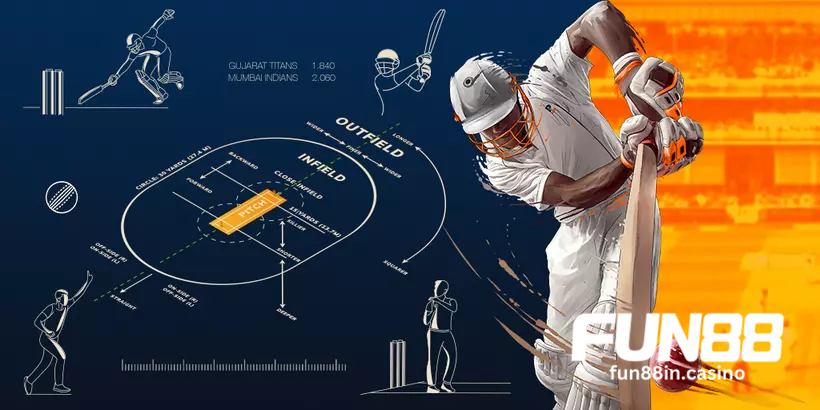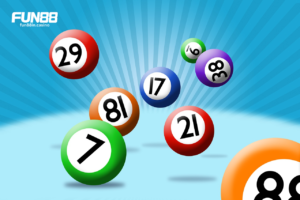Table of Contents
Compared to learning how to bet on cricket, bettors may be more interested in other “intense” sports, such as baseball betting or handball betting on FUN88. However, modern match formats and a wealth of public data have made cricket betting hugely popular.
Cricket Betting – How does this sport work?
Betting
The aim of batting is to score as many runs as possible within a designated “over” (a set of six balls bowled by the bowler) or until all batsmen are dismissed by the umpire(s). Batsmen strike the ball at one end of the pitch, known as the wicket, and change positions with the bowler at the end of each over.
Scoring is achieved by running between the wickets or hitting the ball to the boundary rope, which surrounds the edge of the field. If the ball bounces and crosses the boundary rope, four runs are scored, while if the ball clears the boundary rope without touching the ground, six runs are scored.
Bowling
The aim of bowling is to prevent the batting team from scoring and to dismiss all batting players in the following ways:
| Ways include | descriptions |
|---|---|
| bouncer | The three stumps that the bowler aims to hit and that the batsman must defend are called “wickets”. |
| catch | The batsman hits the ball, and then it is caught by a fielder before it touches the ground. |
| hit wicket (LBW) | The bowler bowls the ball directly onto the batsman’s leg (the trajectory of the ball must be towards the stumps). |
| run out | When the batsman is running to attempt a run, and the ball touches the stumps (either directly bowled or with the ball in hand) before reaching the batsman’s crease. |
|
bowled out |
The batsman attempts a shot, leaving the “crease” (batting area), and the fielder behind him hits the stumps with the ball. |
Cricket features a variety of different bowling techniques and styles, with the most common types of bowling including:
| Types of bowling | descriptions |
|---|---|
| Fast bowling | Right-arm or left-arm, typically exceeding 85 miles per hour |
| Medium-paced bowling | Right-arm or left-arm, typically ranging between 60 to 85 miles per hour |
| Off-spin bowling | Right-arm finger spin bowling, with the ball spinning towards the right-handed batsman and away from the left-handed batsman |
| Leg-spin bowling | Right-arm wrist spin bowling, with the ball spinning away from the right-handed batsman and towards the left-handed batsman |
| Traditional slow bowling | Left-arm finger spin bowling |
| The Chinaman, or left-arm unorthodox spin bowling | Left-arm wrist spin bowling |
How to Bet on Cricket – Understanding Different Match Formats
In different formats of cricket matches, the rules remain the same. However, there are variations in applicable rules when it comes to cricket betting. Each format has different numbers of batting “overs” (the number of times a team bats) and “bowling spells” (the number of overs a bowler bowls).
Here’s an overview of each format:
| Match Formats | Descriptions |
|---|---|
| Top-tier Matches | Each team has two innings, and the match result must be decided within five days (for international matches) or four days (for county/club matches). |
| Limited Overs Matches | Matches completed within a day, with each team having 40 or 50 “overs”. |
| Twenty20 Matches | Modern cricket format with limited overs, where each team only gets 20 “overs” to bat. |
Because of the differences in formats, different teams and players excel in different formats as well. For example, “power hitters” excel in Twenty20 matches (scoring more runs in a shorter time), while more cautious batsmen excel in top-tier matches because they are less likely to get out.
What factors should be considered when betting on cricket?
Like NFL teams, some cricket teams excel in batting while others excel in bowling. This means that some teams have strong batting line-ups while others have excellent bowling capabilities.
Examining the line-ups of each team can help bettors determine whether they are inclined to score as many runs as possible against their opponents or focus on bowling to dismiss the opposition quickly.
When learning how to bet on cricket, it’s essential to consider a primary factor: external factors that may affect the outcome of cricket matches. These external factors include weather, match timing, and the condition of the pitch.
Similar to football betting, some teams have a home advantage over others – partly due to the significant influence of the pitch condition and how well the team maintains it to maximize their strengths.
Cricket teams employ various bowlers, and different bowling types are suitable for different types of wickets. Some wickets may be damp, while others have varying degrees of hardness and grass cover. In general, bettors should consider the following types of wickets:
| Types of wickets include | Suitable |
|---|---|
| Flat wickets | Batsmen – able to easily track the trajectory of the ball |
| Green wickets | Fast bowlers – the ball bounces off the seam after landing |
| Dry wickets | Spin bowlers – the ball grips the cracked pitch, causing it to spin sharply after landing |
Compared to many other sports, cricket is more susceptible to weather conditions because it cannot be played in rainy weather. Additionally, sunlight can dry out the pitch, while rainy areas can make the pitch wetter and the grass denser.
How to Bet on Cricket – Key Points
Finally, FUN88 summarizes the principles of cricket betting for you. Bettors should first understand the rules of the game. Then, they need to grasp the differences in match formats, as well as the formats in which different teams and players excel. Reminder: analyzing pitch conditions and weather forecasts can help assess potential match outcomes.













